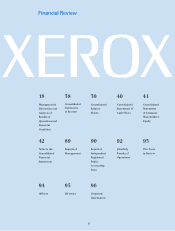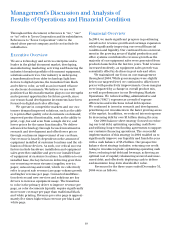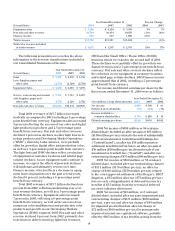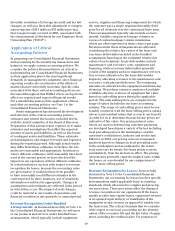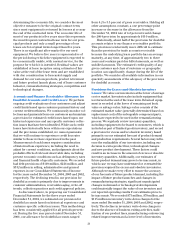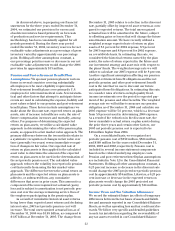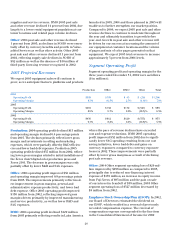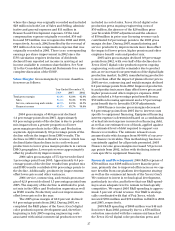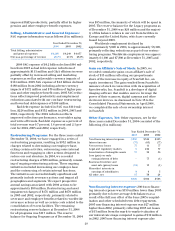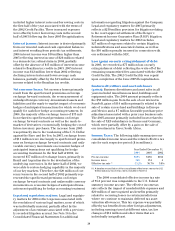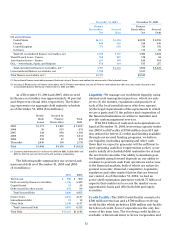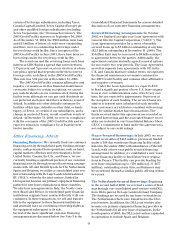Xerox 2004 Annual Report Download - page 25
Download and view the complete annual report
Please find page 25 of the 2004 Xerox annual report below. You can navigate through the pages in the report by either clicking on the pages listed below, or by using the keyword search tool below to find specific information within the annual report.
23
Sheets and provide necessary valuation allowances as
required. We regularly review our deferred tax assets
for recoverability considering historical profitability,
projected future taxable income, the expected timing of
the reversals of existing temporary differences and tax
planning strategies. If we continue to operate at a loss in
certain jurisdictions or are unable to generate sufficient
future taxable income, or if there is a material change
in the actual effective tax rates or time period within
which the underlying temporary differences become
taxable or deductible, we could be required to increase
the valuation allowance against all or a significant por-
tion of our deferred tax assets resulting in a substantial
increase in our effective tax rate and a material adverse
impact on our operating results. Conversely, if and
when our operations in some jurisdictions were to
become sufficiently profitable to recover previously
reserved deferred tax assets, we would reduce all or a
portion of the applicable valuation allowance in the
period when such determination is made. This would
result in an increase to reported earnings in such peri-
od. Adjustments to our valuation allowance, through
charges (credits) to income tax expense, were $12 mil-
lion, $(16) million, and $15 million for the years ended
December 31, 2004, 2003and 2002, respectively. Gross
deferred tax assets of $3.5 billion and $3.7 billion had
valuation allowances of $567 million and $577 million
at December 31, 2004and 2003, respectively.
Weare subject to ongoing tax examinations and
assessments in various jurisdictions. Accordingly, we
incur additional tax expense based upon the probable
outcomes of such matters. In addition, when applica-
ble, we adjust the previously recorded tax expense to
reflect examination results. Our ongoing assessments
of the probable outcomes of the examinations and
related tax positions require judgment and can mate-
rially increase or decrease our effective tax rate as
well as impact our operating results.
Legal Contingencies: We are involved in a variety
of claims, lawsuits, investigations and proceedings
concerning securities law, intellectual property law,
environmental law, employment law and ERISA, as
discussed in Note 14 to the Consolidated Financial
Statements. We determine whether an estimated loss
from a contingency should be accrued by assessing
whether a loss is deemed probable and can be
reasonably estimated. We assess our potential liability
by analyzing our litigation and regulatory matters
using available information. We develop our views on
estimated losses in consultation with outside counsel
handling our defense in these matters, which involves
an analysis of potential results, assuming a combina-
tion of litigation and settlement strategies. Should
developments in anyof these matters cause a change
in our determination as to an unfavorable outcome
and result in the need to recognize a material accrual,
or should any of these matters result in a final adverse
judgment or be settled for significant amounts, they
could have a material adverse effect on our results of
operations, cash flows and financial position in the
period or periods in which such change in determina-
tion, judgment or settlement occurs.
Summary of Results
Segment Revenues
As discussed in Note 2 to the Consolidated Financial
Statements, operating segment financial information
for 2003 and 2002 has been restated to reflect changes
in operating segment structure made during 2004.
Our reportable segments are consistent with how we
manage the business and viewthe markets we serve.
Our reportable segments are Production, Office, DMO
and Other. Our offerings include hardware, services,
solutions and consumable supplies. The Production
segment includes black and white products which
operate at speeds over 90 pages per minute and color
products over 40 pages per minute. Products include
the Xerox iGen3®digital color production press,
DocuColor family, Xerox Nuvera™, DocuTech,
DocuPrint, and Xerox 2101, as well as older technology
light-lens products. The Office segment includes black
and white products which operate at speeds up to
90 pages per minute and color devices which operate
at speeds up to 40 pages per minute. Products
include the suite of CopyCentre®,WorkCentre®,and
WorkCentre®Pro digital multifunction systems,
DocuColor color multifunction products, color laser,
solid ink and monochrome laser desktop printers,
digital and light-lens copiers and facsimile products.
The DMO segment includes our operations in Latin
America, Central and Eastern Europe, the Middle
East, India, Eurasia, Russia and Africa. This segment
includes sales of products that are typical to the
Production and Office segments, however, management
serves and evaluates these markets on an aggregate
geographic basis, rather than on a product basis.
The segment classified as Other includes several
units, none of which met the thresholds for separate
segment reporting. This group includes Xerox
Supplies Business Group (predominantly paper),
SOHO, Wide Format Systems, Xerox Technology
Enterprises and Value-added Services, royalty and
license revenues. Other segment profit (loss) includes
the operating results from these entities, other less
significant businesses, our equity income from
Fuji Xerox, and certain costs which have not been
allocated to the Production, Office and DMO
segments including non-financing interest and
other corporate costs.






